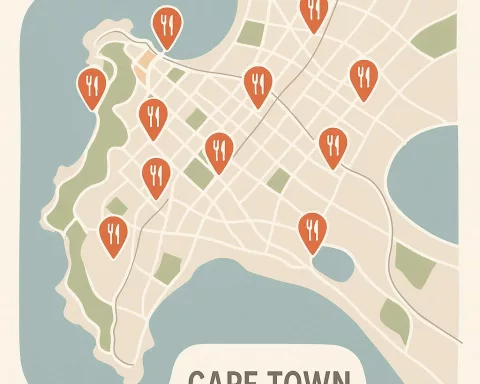Cape Town is facing a serious ocean pollution crisis, with untreated sewage being dumped into its beautiful waters, harming marine life and public health. Activists are fighting for better sewage treatment while city leaders discuss budgets for upgrades, showing a struggle between progress and protecting the environment. Many people, including filmmakers and photographers, are raising awareness about this issue, as rising illness among swimmers adds urgency to the situation. Mayor Hill-Lewis has proposed a big investment for improvements, but activists worry that waiting until 2034 is too long. Cape Town’s situation reflects a bigger global challenge, highlighting the need for balanced solutions that protect both the city and its precious ocean.
What is the ocean pollution crisis in Cape Town?
The ocean pollution crisis in Cape Town involves rising levels of untreated sewage discharged into the sea, threatening marine life and public health. Activists argue for improved sewage treatment standards while city officials propose budget allocations for upgrades, highlighting a clash between development and environmental conservation.
An Unfolding Environmental Catastrophe
The once-pristine waters surrounding Cape Town have become a symbol of a growing environmental crisis. Once a sanctuary for marine life and a hub for recreational activities, these waters now reflect the troubling reality of increasing pollution levels. This pollution crisis has sparked a fervent debate between municipal authorities and environmental activists, each vying for a solution amidst rising concerns over untreated sewage discharges.
Prominent figures in the environmental movement, such as filmmaker Mark Jackson and marine conservation photographer Jean Tresfon, have brought significant attention to this pressing issue. Their advocacy efforts have gained momentum, particularly after their recent meeting with Cape Town’s Mayor Geordin Hill-Lewis and Councillor Paul Jacobson. The primary focus of their discussion was the city’s reliance on marine outfall pipes (MOPs), which discharge partially treated sewage into the ocean. While city officials defend these practices as meeting international standards, activists like Tresfon argue that the level of treatment is grossly inadequate.
The Debate Over Sewage Treatment Standards
In numerous developed countries, sewage undergoes a comprehensive primary treatment process before being released into the ocean. This treatment involves extracting organic matter and significantly reducing contaminants. However, Cape Town’s method of preliminary treatment only removes larger debris through a fine sieve, raising critical concerns about the safeguarding of the city’s marine environment.
Mayor Hill-Lewis acknowledged the persistent issue of pollution in rivers and waterways and emphasized his commitment to increasing transparency. Proposed measures include improved signage at affected beaches and greater public access to water quality data. Despite these assurances, Jackson, leveraging his background as a civil engineer, criticized the city’s summer dashboard for failing to meet international reporting standards. He highlighted that the current system offers data for merely ten weeks, whereas a five-year dataset is recommended for thorough assessment.
Health Implications and Future Projections
The debate took a more urgent turn when the discussion shifted to the rising number of illnesses among swimmers and surfers. City officials attributed these cases to food-related issues, but activists maintained that contaminated water played a significant role. Tresfon pointed out that Cape Town’s burgeoning population would further strain the existing sewage infrastructure, potentially leading to even greater reliance on inadequate marine outfall systems.
Looking to the future, Mayor Hill-Lewis proposed a substantial R10 billion investment to upgrade wastewater treatment facilities. However, construction might not commence until 2034 due to funding and regulatory challenges. Activists, led by Tresfon, regard this timeline as wholly unacceptable. They argue that the cost of inaction far exceeds the financial burden of immediate intervention. Councillor Jacobson called for more urgent measures, including enhanced signage, a beach flag warning system, and stronger budgetary commitments.
Balancing Fiscal Realities with Environmental Necessities
Hill-Lewis conceded that the city had previously neglected its sewage management responsibilities but reassured the public of significant allocation of funds to water and sanitation in the forthcoming budget. Scheduled for release in June, this budget carries the promise of substantial financial commitments aimed at addressing the city’s environmental shortcomings. The city’s leadership faces the challenge of balancing fiscal limitations with the pressing need for environmental stewardship.
The narrative of Cape Town’s environmental struggle is not merely a contemporary issue but resonates with historical tensions between development and conservation. During the colonial era, extensive alterations to Cape Town’s natural landscape often came at the expense of local ecosystems. Today’s debate continues this historical narrative, echoing broader global concerns where economic growth frequently conflicts with environmental sustainability.
A Cultural and Ecological Legacy at Risk
Artistic movements like the Romanticism of the 19th century, which celebrated the sublime beauty of nature, underscore the inherent value of our natural world. Cape Town’s beaches, framed by the imposing Table Mountain, evoke a profound sense of wonder and reverence. This natural splendor is now under threat from pollution, an irony not lost on those advocating for the protection of the city’s marine environment.
Yet, Cape Town is also a city characterized by resilience and innovation. With a rich cultural heritage that spans from its indigenous Khoisan roots to its dynamic contemporary arts scene, the community reflects a collective capability to chart a sustainable future. Grassroots movements and local activism have historically driven meaningful change, suggesting that solutions to the current crisis may well originate from within the community itself.
Cape Town as a Microcosm of Global Challenges
The ocean pollution crisis in Cape Town serves as a microcosm of larger global environmental challenges. As the city confronts the urgent need for reform, the broader narrative of human interaction with nature continues to evolve. The city’s leadership stands at a pivotal juncture, with the opportunity to either navigate towards a cleaner, more sustainable future or yield to the pressures of immediate economic and infrastructural challenges. The upcoming budget and the Mayor’s promised statement will be critical in determining the direction of Cape Town’s environmental policies.
By addressing these issues with urgency and commitment, Cape Town could set a precedent for other cities facing similar environmental dilemmas. The path chosen by the city’s leaders will not only shape the future of Cape Town but also contribute to the global discourse on balancing development with environmental conservation.
“`markdown
FAQ on the Ocean Pollution Crisis in Cape Town
What is the ocean pollution crisis in Cape Town?
The ocean pollution crisis in Cape Town involves rising levels of untreated sewage being discharged into the sea, which threatens marine life and public health. Activists are advocating for improved sewage treatment standards while city officials discuss budget allocations for upgrades, reflecting a tension between development and environmental conservation.
What are the main causes of pollution in Cape Town’s waters?
The primary cause of pollution in Cape Town’s waters is the discharge of partially treated sewage through marine outfall pipes. These pipes only provide preliminary treatment, which raises significant concerns about the protection of the marine environment, as the sewage still contains harmful contaminants.
What health implications are associated with this pollution crisis?
The pollution crisis has led to a rising number of illnesses among swimmers and surfers. While city officials attribute these cases to food-related issues, activists argue that contaminated water is a significant factor. The strain on the existing sewage infrastructure due to Cape Town’s growing population may exacerbate these health risks.
What actions are being proposed to address the crisis?
Mayor Hill-Lewis has proposed a substantial investment of R10 billion to upgrade wastewater treatment facilities; however, construction may not start until 2034. Activists and some city officials are calling for immediate actions, such as enhanced signage at beaches, a beach flag warning system, and stronger budgetary commitments.
How does the pollution crisis in Cape Town reflect larger global challenges?
Cape Town’s ocean pollution crisis serves as a microcosm of global environmental challenges, highlighting the conflict between economic growth and environmental sustainability. The city’s struggle showcases the broader issues of how human activities impact natural ecosystems, urging a need for balanced solutions worldwide.
How can community involvement influence the situation?
Cape Town has a rich history of grassroots movements and local activism, which have historically driven meaningful change. Community involvement can be pivotal in advocating for environmental protection and shaping sustainable policies. By rallying support and raising awareness, residents can help push for urgent reforms in sewage management and marine conservation.
“`









